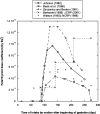Dose Coefficients for Internal Dose Assessments for Exposure to Radioactive Fallout
- PMID: 34898518
- PMCID: PMC8677615
- DOI: 10.1097/HP.0000000000001500
Dose Coefficients for Internal Dose Assessments for Exposure to Radioactive Fallout
Abstract
This paper presents values as well as the bases for calculating internal dose coefficients suitable for estimating organ doses from the exposure to radioactive fallout that could result from the detonation of a nuclear fission device. The 34 radionuclides discussed are the same as those given in a priority list of radionuclides for fallout dose assessments presented in a companion overview paper. The radionuclides discussed are those that are believed to account for a preponderance of the organ doses that might be received by intake by persons of all ages (including in utero and via breast feeding for infants) following exposure to radioactive fallout. The presented dose coefficients for ingestion account for age and include modifications for variations in solubility with distance as discussed previously in the literature, and those for inhalation similarly account for age, solubility, and particle sizes that would be relevant at various distances of exposure as discussed in a companion paper on ingestion dose methods. The proposed modifications peculiar to radioactive fallout account for systematic changes in solubility and particle sizes with distance from the site of detonation, termed here as the region of "local fallout" and the region "beyond local fallout." Brief definitions of these regions are provided here with more detailed discussion in a companion paper on estimating deposition of fallout radionuclides. This paper provides the dose coefficients for ingestion and inhalation (for particle sizes of 1 μm, 5 μm, 10 μm, and 20 μm) for the region "local fallout." These dose coefficients for "local fallout" are specific for particles formed in a nuclear explosion that can be large and have radionuclides, particularly the more refractory ones, distributed throughout the volume where the radionuclide has reduced solubility. The dose coefficients for the region "beyond local fallout" are assumed to be the ones published by the International Commission on Radiological Protection (ICRP) in 1995. Comparisons of the presented dose coefficients are made with values published by the ICRP.
Copyright © 2021 Written work prepared by employees of the Federal Government as part of their official duties is, under the U.S. Copyright Act, a “work of the United States Government” for which copyright protection under Title 17 of the United States Code is not available. As such, copyright does not extend to the contributions of employees of the Federal Government.
Conflict of interest statement
The authors declare no conflicts of interest.
Figures



Similar articles
-
Dose Estimation for Exposure to Radioactive Fallout from Nuclear Detonations.Health Phys. 2022 Jan 1;122(1):1-20. doi: 10.1097/HP.0000000000001501. Health Phys. 2022. PMID: 34898514 Free PMC article.
-
Alimentary tract absorption (f1 values) for radionuclides in local and regional fallout from nuclear tests.Health Phys. 2010 Aug;99(2):233-51. doi: 10.1097/HP.0b013e3181b186ff. Health Phys. 2010. PMID: 20622554 Free PMC article.
-
Estimated Radiation Doses Received by New Mexico Residents from the 1945 Trinity Nuclear Test.Health Phys. 2020 Oct;119(4):428-477. doi: 10.1097/HP.0000000000001328. Health Phys. 2020. PMID: 32881738 Free PMC article.
-
Review of methods of dose estimation for epidemiological studies of the radiological impact of nevada test site and global fallout.Radiat Res. 2006 Jul;166(1 Pt 2):209-18. doi: 10.1667/RR3172.1. Radiat Res. 2006. PMID: 16808609 Review.
-
Radionuclide characterization and associated dose from long-lived radionuclides in close-in fallout delivered to the marine environment at Bikini and Enewetak Atolls.Sci Total Environ. 1999 Sep 30;237-238:311-27. doi: 10.1016/s0048-9697(99)00145-x. Sci Total Environ. 1999. PMID: 10568285 Review.
Cited by
-
A Methodology for Calculation of Internal Dose Following Exposure to Radioactive Fallout from the Detonation of a Nuclear Fission Device.Health Phys. 2022 Jan 1;122(1):84-124. doi: 10.1097/HP.0000000000001503. Health Phys. 2022. PMID: 34898517 Free PMC article.
-
A Historical Survey of Key Epidemiological Studies of Ionizing Radiation Exposure.Radiat Res. 2024 Aug 1;202(2):432-487. doi: 10.1667/RADE-24-00021.1. Radiat Res. 2024. PMID: 39021204 Free PMC article. Review.
-
Parameter Values for Estimation of Internal Doses from Ingestion of Radioactive Fallout from Nuclear Detonations.Health Phys. 2022 Jan 1;122(1):236-268. doi: 10.1097/HP.0000000000001493. Health Phys. 2022. PMID: 34898519 Free PMC article.
-
The overview of neutron-induced 56Mn radioactive microparticle effects in experimental animals and related studies.J Radiat Res. 2022 Aug 13;63(Supplement_1):i1-i7. doi: 10.1093/jrr/rrac020. J Radiat Res. 2022. PMID: 35968985 Free PMC article.
References
-
- Aden IJ, Scott BR. Modeling variability and uncertainty associated with inhaled weapons-grade PuO2. Health Phys 84:726–736; 2003. - PubMed
-
- Apostoaei AI, Miller LF. Uncertainties in dose coefficients from ingestion of 131I, 137Cs, and 90Sr. Health Phys 86:460–482; 2004. - PubMed
-
- Basic M, Kasal B, Simonovic I, Jukic S. 131I dose to the human fetal thyroid in the Zagreb District, Yugoslavia, from the Chernobyl accident. Intl J Radiat Biol 54:167–177; 1988. - PubMed
Publication types
MeSH terms
Substances
Grants and funding
LinkOut - more resources
Full Text Sources

